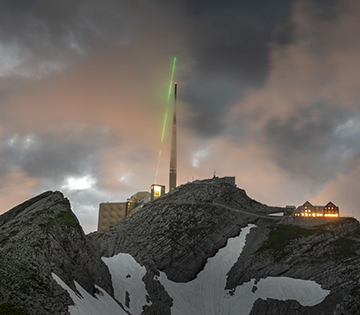![]()
The laser and machine tools conglomerate Trumpf, working with academic and industry partners, has installed a terawatt-scale, high-repetition-rate pulsed laser at the top of a 2500-m mountain in the Swiss Alps. The facility will test whether a “laser lightning rod” can control and redirect lightning strikes. [Photo: Trumpf]
The Germany-based laser and machine tool behemoth Trumpf announced that—working with scientists at the University of Geneva, Switzerland, and other organizations—it has hauled a 5-ton, 9-m-long “super laser” to the top of Säntis mountain in the Swiss Alps, and has installed and fired up the terawatt-scale light source. The ultimate goal of this audacious exercise: Demonstrate the ability of lasers to control and safely redirect lightning strikes.
Guiding lightning via filamentation
The “Laser Lightning Rod” project is a nearly €4-million EU-funded scheme designed to prove out the concept of using laser filamentation to create lengthy, transient tunnels in the atmosphere. Such tunnels, in turn, might safely guide lightning away from airports, nuclear power plants, skyscrapers, forests and other vulnerable sites. According to Trumpf, the damage that lightning strikes cause to such sites runs into the billions of euros a year, with storms and lightning in the United States alone estimated to exact an economic cost of some US$5 billion a year.
Under the Laser Lightning Rod demonstration scheme, the high-repetition-rate Trumpf laser will fire a thousand laser pulses per second into the atmosphere above the Säntis mountain facility. The ultrashort pulses, owing to the nonlinear Kerr effect, should change the refractive index of the atmospheric medium, leading to laser self-focusing and the formation of a plasma channel in the atmosphere. In principle, the channel would create a preferential path for lightning strikes, diverting them along the filament and away from sensitive facilities and installations.
“Perfect choice” for an experiment

The Trumpf laser was installed at the summit of 2500-m-high Säntis mountain. [Photo: Trumpf]
According to Trumpf, Säntis mountain constitutes “the perfect choice” for testing such a scheme, as it is pelted by hundreds of lightning strikes during the Northern Hemisphere summer months. This past May, the company put a significant effort into getting the giant laser up the 2500-m-high mountain, taking the lab-tested instrument—itself the result of four years of development—up to the summit piece by piece via mountain cable cars and helicopters.
After putting the laser back together and giving it a test firing, the research team has begun “weather experiments” that will proceed over the next several weeks, with preliminary results expected by the end of the summer. “The laser works perfectly in the lab,” Trumpf laser engineer Clemens Herkommer noted in a company press release, “and we’re very optimistic that it can control lightning in the atmosphere, too.”
In addition to personnel from Trumpf and the University of Geneva, the Laser Lightning Rod project also involves the French National Centre for Scientific Research (CNRS); the AMC consultancy firm; the Swiss Federal Institute of Technology Lausanne; the ArianeGroup aerospace company; and the University of Applied Sciences and Arts, Western Switzerland.
